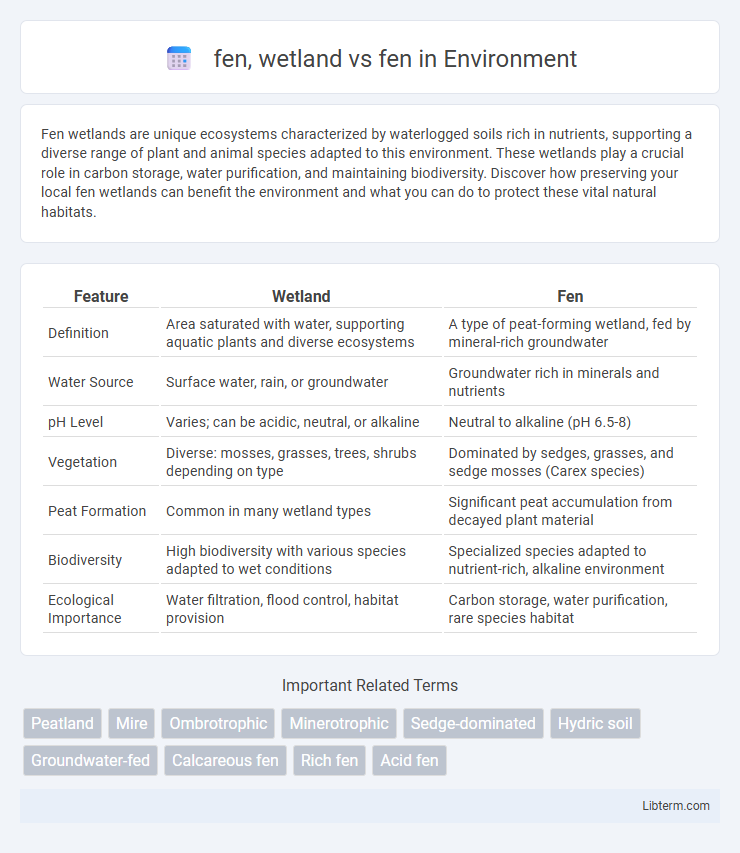Fen wetlands are unique ecosystems characterized by waterlogged soils rich in nutrients, supporting a diverse range of plant and animal species adapted to this environment. These wetlands play a crucial role in carbon storage, water purification, and maintaining biodiversity. Discover how preserving your local fen wetlands can benefit the environment and what you can do to protect these vital natural habitats.
Table of Comparison
| Feature | Wetland | Fen |
|---|---|---|
| Definition | Area saturated with water, supporting aquatic plants and diverse ecosystems | A type of peat-forming wetland, fed by mineral-rich groundwater |
| Water Source | Surface water, rain, or groundwater | Groundwater rich in minerals and nutrients |
| pH Level | Varies; can be acidic, neutral, or alkaline | Neutral to alkaline (pH 6.5-8) |
| Vegetation | Diverse: mosses, grasses, trees, shrubs depending on type | Dominated by sedges, grasses, and sedge mosses (Carex species) |
| Peat Formation | Common in many wetland types | Significant peat accumulation from decayed plant material |
| Biodiversity | High biodiversity with various species adapted to wet conditions | Specialized species adapted to nutrient-rich, alkaline environment |
| Ecological Importance | Water filtration, flood control, habitat provision | Carbon storage, water purification, rare species habitat |
Introduction to Fens and Wetlands
Fens are a specific type of wetland characterized by peat-forming ecosystems fed by nutrient-rich groundwater, supporting diverse plant communities like sedges, grasses, and wildflowers. Unlike bogs, which are acidic and nutrient-poor, fens maintain higher pH levels and mineral content, fostering unique biodiversity. Wetlands encompass various ecosystems including marshes, swamps, and fens, each distinguished by hydrology, soil type, and vegetation patterns.
What Defines a Fen?
A fen is a type of wetland characterized by its alkaline, nutrient-rich, and groundwater-fed environment, supporting a diverse range of plant species including sedges, grasses, and wildflowers. Unlike bogs, which are acidic and nutrient-poor, fens have higher pH levels and greater mineral content due to their water source. The unique hydrology and chemistry of a fen create distinctive habitats that contribute significantly to biodiversity and carbon cycling in wetland ecosystems.
Key Characteristics of Wetlands
Fens are a specific type of wetland characterized by their alkaline, nutrient-rich waters caused by groundwater flow through mineral soils. Unlike acidic bogs, fens support diverse plant species including sedges, grasses, and wildflowers due to higher pH and mineral content. Wetlands in general function as critical ecosystems for water filtration, flood control, and habitat diversity, with fens playing a unique role in maintaining groundwater quality and supporting rare biodiversity.
Formation of Fens: Processes and Factors
Fens form through the slow accumulation of peat in waterlogged conditions where groundwater rich in minerals, particularly calcium and magnesium, creates alkaline, nutrient-rich environments. Unlike bogs, which are primarily rain-fed and acidic, fens receive continuous inflow of groundwater and surface water, influencing their distinct chemical composition and plant communities. Key factors in fen formation include hydrology, mineral input, and topography, which collectively support diverse sedges, grasses, and moss species adapted to these moderately alkaline wetlands.
Hydrology: Comparing Fens and Other Wetlands
Fens are groundwater-fed wetlands characterized by neutral to alkaline pH, supporting unique plant communities adapted to stable water chemistry and nutrient inputs. Unlike bogs, which receive water primarily from precipitation, fens maintain constant hydrology through mineral-rich groundwater, influencing their high biodiversity and carbon storage capacity. This hydrological distinction shapes fen ecosystems, differentiating them from other wetlands such as marshes and swamps, which experience more variable water sources and nutrient levels.
Vegetation Differences: Fen vs. Wetland
Fens are nutrient-rich wetlands dominated by sedges, grasses, and brown mosses, while general wetlands encompass diverse vegetation including reeds, cattails, and broadleaf shrubs. Fens support specialized plant communities adapted to alkaline, mineral-rich groundwater, contrasting with acidic, nutrient-poor environments typical of bog wetlands. The vegetation differences reflect distinct hydrological and chemical conditions, influencing biodiversity and ecological functions in fen versus other wetland ecosystems.
Biodiversity in Fens and Wetlands
Fens are nutrient-rich wetlands characterized by alkaline, groundwater-fed conditions that support a diverse array of plant species, including sedges, grasses, and mosses, creating unique habitats for specialized fauna. Unlike general wetlands, which can vary widely in nutrient levels and hydrology, fens maintain stable water chemistry that fosters high biodiversity and endemic species that rely on consistent moisture and pH levels. The biodiversity in fens includes rare orchids, specialized invertebrates, and bird species that are dependent on these distinct environmental conditions, highlighting their critical ecological role within wetland landscapes.
Ecological Functions and Benefits
Fens are nutrient-rich wetlands characterized by alkaline, groundwater-fed conditions that support diverse plant communities, including sedges, grasses, and wildflowers. Unlike other wetlands, fens facilitate essential ecological functions such as carbon sequestration, water filtration, and habitat provision for rare species like the bog turtle and marsh marigold. Their unique hydrology and biodiversity contribute significantly to nutrient cycling and maintaining regional water quality.
Conservation Challenges: Fen vs. Wetland
Fen ecosystems, characterized by their calcium-rich, groundwater-fed soils, face unique conservation challenges compared to broader wetlands, which include diverse habitats such as marshes and swamps. Fens are particularly vulnerable to nutrient enrichment, hydrological alterations, and peat extraction, which disrupt their distinct plant communities and carbon storage capabilities. Wetland conservation efforts must address these specific threats to fens while managing broader wetland issues like habitat fragmentation and invasive species.
Conclusion: Why Fens Matter in Wetland Ecosystems
Fens play a critical role in wetland ecosystems by supporting unique biodiversity and regulating hydrological cycles through their groundwater-fed conditions rich in mineral nutrients. Unlike bogs dominated by acidic, nutrient-poor environments, fens maintain higher pH levels and nutrient availability, fostering diverse plant and microbial communities essential for ecosystem health. Protecting fens contributes to climate regulation, water purification, and habitat conservation, highlighting their importance within global wetland networks.
fen, wetland Infographic

 libterm.com
libterm.com